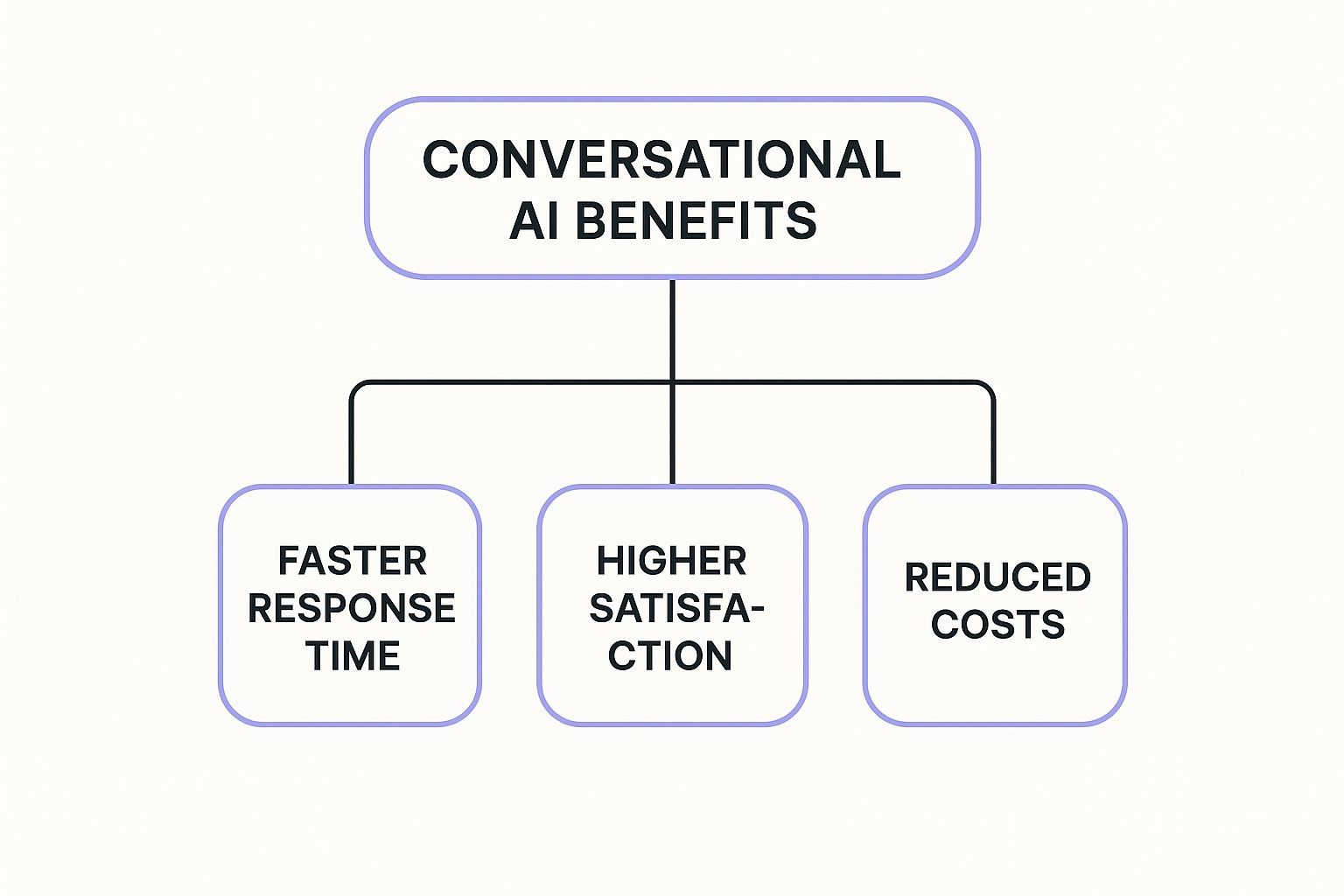When we talk about WhatsApp Channel for customer service, we're not just talking about a fancier chatbot. We're talking about technology that allows your customers to have surprisingly natural, human-like conversations with digital assistants, 24/7. Think of it as a smart, automated teammate—one that handles routine questions instantly so your human agents can tackle the tougher problems.
Why Customer Support Is Ready for a Change
We’ve all been there. Stuck on hold, listening to that same looping music, only to have to repeat our issue to three different people. That frustrating cycle is a classic symptom of traditional customer support, a system that’s buckling under the weight of modern expectations for immediate, effective help. This shared pain point is exactly why so many businesses are looking for a better way.
This is where conversational AI for customer service comes in. Don't picture a clunky, script-bound robot. Instead, imagine a brilliant digital co-worker. This tech is built to actually understand what customers are asking by figuring out their intent, the context of their problem, and even their sentiment. It’s a complete shift away from making customers wait and toward giving them immediate value.

The Urgent Need for Smarter Solutions
The demand for faster service isn't just a preference anymore; it's an expectation. Customers just don't have the patience for long phone queues or email responses that take days to arrive. AI steps in to manage the flood of routine questions that can easily overwhelm support teams. In fact, projections show that AI will power around 95% of all customer interactions by 2025—a clear signal of how essential this technology is becoming. You can see more on this trend from Zendesk's analysis of customer service trends.
This evolution allows businesses to meet customer needs around the clock without having to hire endless teams of people. It tackles core operational headaches while making the customer's journey much smoother. You can dig deeper into the mechanics in our guide on AI customer service.
The core idea is simple: let technology handle the predictable, repetitive tasks so your human experts can focus on the situations that require empathy, complex problem-solving, and a personal touch. This creates a win-win for everyone involved.
This partnership between human and machine intelligence delivers real benefits that you can feel across the entire organization.
To give you a clearer picture, here's a quick breakdown of how these pieces fit together.
Conversational AI at a Glance
| Core Capability | Customer Benefit | Business Impact |
|---|---|---|
| Natural Language Understanding (NLU) | The AI understands what I'm asking, even if I don't use specific keywords. | Fewer misunderstandings and faster, more accurate resolutions. |
| 24/7 Instant Responses | I get an answer right away, no matter when I ask. No more waiting. | Radically improved response times and higher customer satisfaction. |
| Automated Issue Resolution | My simple problems (like order status) are solved on the spot. | Frees up human agents to focus on complex issues, boosting overall team productivity. |
This table shows just how directly the technology's features translate into tangible wins for both your customers and your bottom line.
Key Benefits Driving Adoption
The move toward conversational AI for customer service is happening for a reason. It's fueled by clear, measurable advantages that improve both customer happiness and business efficiency. Companies that bring this tech on board tend to see improvements almost immediately.
- Instant, 24/7 Availability: AI agents don't sleep. They’re there to provide immediate answers any time of day, any day of the week, which is a must-have for serving a multilingual customer service for a global audience.
- Improved Team Efficiency: By automating the common questions like "Where is my order?" or "How do I reset my password?", AI gives your human agents their time back. They can then dedicate their skills to more challenging customer situations.
- Higher Customer Satisfaction: Fast, accurate answers make for happy customers. When you reduce friction and kill wait times, you create a smoother, more positive experience that builds real brand loyalty.
These immediate gains are just the beginning. They set the stage for bigger, long-term strategic advantages, making conversational AI a vital piece of any modern customer service puzzle.
How This AI Actually Understands Your Customers
To really get why conversational AI for customer service is such a big deal, you have to peek under the hood. It might feel like magic on the surface, but it’s actually a clever system of interlocking parts working together. They turn a customer's jumbled question into a surprisingly helpful and accurate answer.
Think of it as a four-step process for a machine to have a real conversation.
It all starts with something called Natural Language Processing (NLP). At its heart, NLP is the branch of AI that gives computers the ability to read, figure out, and make sense of human language. It’s like we’re teaching the machine grammar, context, and slang—all the messy rules we use to talk to each other every day.
The Art of Listening with NLU
From there, we drill down into Natural Language Understanding (NLU), which is a vital piece of the NLP puzzle. If NLP is the textbook, NLU is the ability to listen and comprehend in a live conversation. It’s not just about recognizing words; it’s about grasping the intent—what the person is really trying to do.
For example, one customer might type, “My order is late,” while another asks, “Where’s my package?” or even, “When will my stuff get here?” The words are completely different, but NLU is smart enough to see the intent is the same: they all want to check an order status. This is what lets the AI move past simple keyword matching and figure out what the user actually needs.
NLU is the secret sauce that makes conversational AI genuinely helpful. It deciphers not just the what (the words) but the why (the user’s goal). That’s the key to giving a relevant answer instead of a frustrating "I don't understand."
Speaking the Language of Your Customers with NLG
Once the AI understands what the customer wants, it has to put together a reply. This is where Natural Language Generation (NLG) steps in. You can think of NLG as the "speaking" part of the AI, responsible for turning structured data into normal, human-sounding text.
So, instead of spitting out a cold, robotic response, a modern AI uses NLG to create a message that feels natural and context-aware. It can pull the order number from one system, the shipping status from another, and weave them into a clear sentence like, “Your order #12345 has shipped and is scheduled for delivery tomorrow.”
This infographic breaks down how these technologies lead to core business benefits.

As you can see, by understanding and responding like a human, the AI directly improves the numbers that matter most to the business.
The Brain That Gets Smarter Over Time
The component tying all of this together is Machine Learning (ML). This is the engine that allows the AI to learn and improve from every single conversation it has. Think of it as the system’s long-term memory and its ability to get sharper with experience.
Every chat is a new lesson. ML algorithms sift through these interactions, spotting patterns, fine-tuning their grasp of customer intents, and making their future responses better. If you're curious about the nitty-gritty of how these systems process information, it's worth exploring the AI's use of JSON data to structure and exchange information behind the scenes.
This constant learning loop means the AI doesn’t just sit there. It evolves, becoming more accurate, efficient, and human-like with each customer it helps.
Real-World Wins with Conversational AI

Talking about benefits in theory is fine, but seeing conversational AI for customer service actually work in the wild is where its value really clicks. different types of chatbots across all sorts of industries, companies are using smart AI agents to fix specific, nagging problems—and they're seeing real, measurable wins.
These examples aren't just hypotheticals. They show how the technology goes from a neat idea to a core part of the business, turning customer service headaches into genuine opportunities for growth.
E-commerce Peak Season Survival
For any e-commerce brand, big shopping seasons like Black Friday are both a blessing and a curse. The support inbox gets flooded with the same question over and over: "Where is my order?" Trying to handle thousands of these tickets manually is a fast track to long wait times and unhappy customers.
One major online retailer tackled this head-on by putting an AI assistant on their website and messaging apps. They hooked it up to their order management system, which let the AI give instant, personalized shipping updates on demand.
The results were immediate and powerful:
- 70% of "Where is my order?" tickets were resolved instantly, without a human agent ever touching them.
- This freed up the support team to focus on the tricky stuff, like complex returns and claims for damaged items.
- Customer satisfaction scores held steady during the busiest season, avoiding the usual holiday dip.
This is a perfect example of conversational AI acting as a pressure valve, making sure service quality doesn't tank when things get crazy.
Secure and Instant Financial Services
A fintech company had a different problem to solve: giving customers secure, instant access to their sensitive account info. People constantly need to check their balance, look at recent transactions, or report fraud—all things that demand both speed and airtight security.
They rolled out a sophisticated AI bot that could securely verify a user's identity before sharing any details. The bot handled balance checks, flagged sketchy-looking transactions, and even walked users through freezing a lost card. For a closer look at the kinds of functions that make this possible, you can check out Cometly's AI Chat features.
By automating these crucial but routine tasks, the company gave customers self-service tools they could actually trust, 24/7. It didn't just make for a better customer experience; it also took a massive load off their specialized fraud and support teams.
Personalized Travel Planning on Demand
The travel industry is incredibly competitive. Helping a customer sift through endless options to build the perfect trip can be a huge time sink for agents. One travel company decided to use a conversational AI agent to act as a personal travel assistant for every user.
The AI would start by asking smart questions about budget, travel dates, and interests to get a feel for what the user wanted. Then, it would scan flight deals and hotel availability in real time to serve up personalized recommendations. Users could even build and tweak a whole itinerary right there in the chat.
This turned what was once a passive browsing experience into an active, helpful conversation. This kind of AI adoption is part of a much bigger trend. The global chatbot market—a key piece of conversational AI for customer service—was valued at roughly $15.57 billion in 2025 and is on track to hit $46.64 billion by 2029. You can discover more insights about this rapid growth.
To see how these applications vary, let's look at a few industries side-by-side.
Conversational AI Use Cases by Industry
This table gives a quick comparative look at how different sectors are putting conversational AI to work to solve their unique customer service challenges.
| Industry | Primary Use Case | Key Outcome |
|---|---|---|
| Retail & E-commerce | Order tracking, product recommendations, and returns processing | Reduced support tickets during peak seasons and increased average order value |
| Financial Services | 24/7 account support, fraud alerts, and lead qualification | Enhanced security, improved customer trust, and higher lead conversion rates |
| Healthcare | Appointment scheduling, medication reminders, and symptom checking | Improved patient engagement and reduced administrative workload |
| Travel & Hospitality | Booking assistance, itinerary planning, and local recommendations | More personalized travel experiences and higher booking completion rates |
Each industry finds its own "sweet spot" for AI, targeting the repetitive tasks that bog down their teams and frustrate their customers.
These real-world wins all point to the same conclusion. The most successful AI projects aren't about replacing people. They're about finding those high-volume, frustrating pain points and deploying AI as a smart, automated solution that makes everyone's life easier.
Your Blueprint for a Successful AI Launch

Jumping into conversational AI for customer service can feel like a massive project, but a great launch doesn't happen by chance. It happens with a plan. By breaking the journey down into a practical roadmap, you can bring this tech into your workflow methodically and see a real impact from day one.
A structured approach keeps you from falling into common traps, like trying to get your AI to do everything all at once. Instead, you'll focus on smart, targeted improvements that make an immediate difference for your team and your customers.
Define Your Mission
Before you even think about technology, you have to nail down your "why." What specific customer headache are you trying to cure? Every successful AI project starts with a laser-focused goal. Forget about building an AI that can do it all. Find the one thing it must do exceptionally well.
Start by digging into your support tickets. Look for the most common, repetitive questions clogging up your queue.
- Are customers constantly asking, "Where's my order?"
- Is your team buried in password reset requests?
- Do you get hundreds of questions about your return policy every single week?
These are perfect candidates for automation. Picking one or two of these high-volume tasks gives your AI a clear mission and an easy way to measure success. You solve a real problem and prove the value of the project, fast.
Choose Your Tech Partner
Once you know what you're solving, it's time to pick the right tool for the job. You really have two main paths here: building a custom solution from the ground up or partnering with a ready-made platform.
Building your own AI gives you total control, but be prepared for a serious investment in time, money, and specialized developers. For most small and medium-sized businesses, it’s just not practical.
A no-code platform, on the other hand, is built for speed. These tools come pre-trained and are designed to plug right into the systems you already use—like your CRM or e-commerce store—without needing an engineering team. It’s a much faster and more accessible way to get started.
Design Conversations That Actually Help
With a platform selected, the next step is designing the conversation itself. The goal is to create dialogue that feels natural and helpful, not robotic and frustrating. A well-designed conversation guides the user straight to a solution with as little friction as possible.
Put yourself in your customer's shoes. What information do they need to fix their problem? What follow-up questions are they likely to have?
A great conversational AI experience anticipates what the user needs next. If a customer asks about a return, the AI shouldn't just recite the policy—it should offer to start the return process right there in the chat.
This proactive approach turns a simple Q&A into a genuinely useful interaction. For those looking to go deeper, you can find some fantastic strategies to automate customer support while keeping the conversation feeling human.
Train, Test, and Refine
Your AI's launch isn't the finish line; it's just the start. The final—and most important—stage is a continuous cycle of training, testing, and refining. This is how your conversational AI for customer service evolves from good to great.
Start by feeding your AI all your existing knowledge base articles, FAQs, and canned responses. This gives it a solid foundation of accurate information to work with.
Next, test it internally. Have your own team throw curveball questions at the AI and try to "break" it. This helps you find the weak spots and knowledge gaps before your customers do.
Once it's live, the real work begins. Obsess over the conversation logs and analytics.
- Where are customers getting stuck or confused?
- At what point do they ask for a human agent?
- Which answers are working best?
Use these insights to constantly tweak the AI's dialogue and expand what it knows. This iterative process is what ensures your AI gets smarter and more helpful with every single customer it talks to.
Best Practices That Drive Real Results
Getting a conversational AI up and running is a huge step. But the real work—the part that separates a frustrating bot from a genuinely helpful digital assistant—begins after you go live.
Following a few proven best practices is what ensures your AI investment actually pays off, strengthening customer relationships instead of straining them.
First up is something most people overlook: giving your AI a personality. This isn't just about being witty; it's about brand alignment. Your AI is often the first "voice" a customer interacts with, so its tone needs to feel like it's coming from your company, whether that's professional and buttoned-up or friendly and informal.
Design for a Seamless Human Handoff
Let's be realistic: no AI can solve every single problem, and that’s perfectly fine. The biggest mistake you can make is trapping a customer in a frustrating automated loop with no way out. A smooth, transparent handoff to a human agent isn't a nice-to-have; it's non-negotiable.
A good handoff doesn't just dump the customer into a live chat queue. The AI should gather all the context—who the customer is, what they need, and the conversation history so far—and pass it all to the human agent. This simple step means the customer never has to repeat themselves, turning a potential moment of frustration into one of impressive efficiency.
Key Takeaway: An effective AI knows its own limits. The goal isn't 100% containment. It's about providing the best possible path to a solution, whether that's with the AI or a human expert.
By designing this transition thoughtfully, you show you respect the customer's time and empower your team to jump in with the full picture, ready to solve the problem fast.
Manage Expectations and Build Trust
Another critical point is just being honest. Customers are smart—they appreciate knowing when they're talking to an AI. Being upfront from the very beginning helps set the right expectations and starts the conversation off with a foundation of trust.
A simple opener like, "Hi, you're chatting with our automated assistant," can prevent a world of misunderstanding. It frames the interaction correctly, encouraging customers to use clear, direct language that the AI can understand, which ultimately gets them a faster, more accurate answer.
And it turns out, customers are often perfectly happy with this. This chart shows that when they need an immediate response, most consumers actually prefer a bot.
The data is clear: when speed is the priority, 51% of customers are more than willing to engage with an AI. This just reinforces why it’s so important to make that experience a great one.
Obsess Over Conversation Data for Improvement
A truly great conversational AI is never "finished." Think of it as a living tool that needs to be constantly coached and improved. The secret to that improvement is hiding in plain sight: your conversation data. You have to regularly dig into interaction logs to find where you can do better.
- Find Failure Points: Where are conversations breaking down or needing a human rescue? This points directly to gaps in your AI's knowledge or clunky dialogue flows that need fixing.
- Spot New Automation Opportunities: Are customers repeatedly asking a new question your AI can't answer yet? That's a clear signal to teach your AI a new skill and take more repetitive tasks off your team's plate.
- Refine What Already Works: Look at which answers lead to the highest customer satisfaction. Use those insights to tweak and improve responses across the board.
This constant feedback loop is the engine that drives AI performance. When you treat your AI like a digital employee that needs ongoing training, it evolves from a simple tool into an increasingly powerful asset. Exploring the many benefits of AI in customer service shows just how much this continuous improvement directly impacts your bottom line and keeps customers loyal.
Of course. Here is the rewritten section, crafted to sound completely human-written and natural, following all the specified guidelines and matching the provided examples.
Common Questions About AI in Customer Service
Even with all the clear upsides, bringing any new tech into your business raises some fair questions. When it comes to conversational AI for customer service, most leaders I talk to have the same handful of concerns. Let's tackle them head-on.
This is where we cut through the noise and give you straight answers, helping you separate the hype from the reality of what AI can do for your support strategy.
Will Conversational AI Replace My Human Agents?
Nope. In fact, it's designed to make them better at their jobs. Think of conversational AI less as a replacement and more like a powerful new teammate.
It's brilliant at instantly handling the simple, repetitive questions that clog up your support queue. This is a massive win for your human agents. By automating the routine stuff, the AI frees up your team to focus on the complex, high-value conversations—the ones that truly need empathy, critical thinking, and a human touch.
The goal isn't to remove humans from the loop, but to place them where they can make the biggest impact. AI handles the predictable, and humans handle the exceptional.
The best strategies create a real partnership where the AI manages the common tasks, with a smooth and easy handoff to a human expert whenever it's needed. It's a model that boosts both your team's efficiency and the quality of your customer service.
How Much Does It Actually Cost to Implement?
This is one of those "it depends" answers, but for good reason. The cost of implementing conversational AI can vary quite a bit, depending on your goals and how big your operation is.
For a small business or a startup, a simple chatbot on a subscription platform can be incredibly affordable and deliver value right away without a big upfront investment. On the other end, a large enterprise wanting a custom-built AI that plugs deep into internal systems like a CRM or ERP is naturally looking at a more significant project.
The good news? The market is full of options. Many providers offer tiered pricing, letting you start small and prove the value. You can get a focused solution running, show the ROI, and then scale your investment as your business and needs grow.
How Do I Know If My AI Is Actually Working?
Success isn't just a feeling; it’s something you measure. To know if your AI is really pulling its weight, you have to track the right Key Performance Indicators (KPIs), focusing on both customer experience and operational metrics.
Here are the core metrics to keep an eye on:
- Resolution Rate: What percentage of issues does the AI solve all on its own, without a human stepping in? This is a direct measure of its effectiveness.
- Customer Satisfaction (CSAT): Are customers actually happy with the AI? A quick survey after a chat gives you direct, unfiltered feedback.
- Containment Rate: How many conversations are fully handled by the AI from start to finish? This tells you exactly how much work it's taking off your team's plate.
- Escalation Rate: How often does the AI need to hand a conversation over to a human? A high rate here can point to gaps in the AI's knowledge that you need to fill.
What Is the Biggest Mistake Companies Make?
The single most common mistake is treating AI as a "set it and forget it" project. A successful conversational AI for customer service isn't a static tool you just switch on. It’s a living system that needs ongoing attention.
Companies that don't bother to regularly analyze conversation data, update the AI's knowledge, and tweak its responses will inevitably watch its performance slide. The teams who get it right treat their AI like a digital employee—one that needs continuous training and development to stay sharp and perform at its best.
Ready to see how a smart AI teammate can transform your customer support? FlowGent AI provides a no-code platform to deploy intelligent agents across all your customer channels, from your website to WhatsApp Business AI. Start resolving issues instantly, boosting team efficiency, and delivering the 24/7 service your customers expect. Explore FlowGent AI today.



